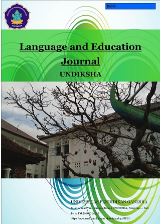STUDENTS’ NEEDS ANALYSIS IN DEVELOPING ENGLISH FOR TOURISM LEARNING MATERIALS AT SMA ASTIKA DHARMA
DOI:
https://doi.org/10.23887/leju.v5i1.44386Keywords:
Students’ needs, tourism learning material, English for TourismAbstract
This study aimed at determining the needs of students in the development of English for tourism learning materials at SMA Astika Dharma. This study used a descriptive method with reference to a qualitative approach. The research subjects of this field study were students of class X and XI of SMA Astika Dharma. The data collection technique used was a questionnaire technique to determine the needs of students in developing tourism learning materials. The instrument of data collection in this study was a questionnaire. This study uses descriptive statistical analysis techniques used to process questionnaire data on student needs in the development of tourism teaching materials at SMK Astika Dharma. The results showed that (1) English for Tourism is different from general English, (2) The digital teaching materials needed by students are digital teaching materials that are easily accessible, easy to understand, visually appealing, have audio access, and can be accessed anytime, (3) The language used for digital teaching materials for tourism English lessons is Indonesian and English (bilingual), (4) The form of digital tourism teaching materials desired by the majority of students is in the form of learning videos.
References
Agusta, E., & Nuraini, N. (2019). Bilingual Module Innovation With Saintific-Based Regulated Learning Self Strategy. Formatif: Jurnal Ilmiah Pendidikan MIPA, 9(1), 33–44. https://doi.org/10.30998/formatif.v9i1.2918
Ahmadiyanto. (2016). Meningkatkan Aktivitas Dan Hasil Belajar Siswa Menggunakan Media Pembelajaran Ko-Ruf-Si ( Kotak Huruf Edukasi ) Berbasis Word Square Pada Materi Kedaulatan Rakyat Dan Sistem Pemerintahan Di Indonesia Kelas Viiic Smp. Jurnal Kependidikan Kewarganegaraan, 6(2), 980–993. http://ppjp.ulm.ac.id/jpournal/index.php/pkn/article/view/2326/2034
Arikunto, S. (2013). Prosedur Penelitian Suatu Pendekatan Praktik. PT Rineka Cipta.
Kairupan, S. B. (2015). Pengembangan Bahan Pembelajaran pariwisata sebagai Mulokpada Siswa SLTP di Kabupaten Minahasa Sulawesi Utara. Jurnal Inovasi Dan Teknologi Pembelajaran, 1(2), 155–164.
Khairani, M., Sutisna, & Suyanto, S. (2019). Meta-analysis study of the effect of learning videos on student learning outcomes. Journal of Biological Education and Research, 2(1), 155–164.
Magdalena, I., Sundari, T., Nurkamilah, S., Nasrullah, & Amalia, D. A. (2020). Analisis Bahan Ajar. Nusantara : Jurnal Pendidikan Dan Ilmu Sosial, 2(2), 311–326.
Ratmanida. (2012). KESELARASAN ANTARA KEBUTUHAN BAHASA INGGRIS DENGAN MATERI AJAR BAHASA INGGRIS MAHASISWA JURUSAN AKUTANSI Ratmanida Jurusan Bahasa dan Sastra Inggris FBS UNP. 6(1), 59–66.
Sapriyah. (2019). Peran Media Pembelajaran Dalam Proses Belajar Mengajar. Prosiding Seminar Nasional Pendidikan FKIP, 2(1), 470–477. https://doi.org/10.35446/diklatreview.v3i1.349
Sukmadinata, N. S. (2012). Metode Penelitian Pendidikan. PT Remaja Rosdakarya.
Yustanti, I., & Novita, D. (2019). Pemanfaatan E-Learning Bagi Para Pendidik Di Era Digital 4.0. Prosiding Seminar Nasional Pendidikan Program Pascasarjana Universitas PGRI Palembang, 338–346. https://doi.org/10.47647/jsh.v2i2.169










